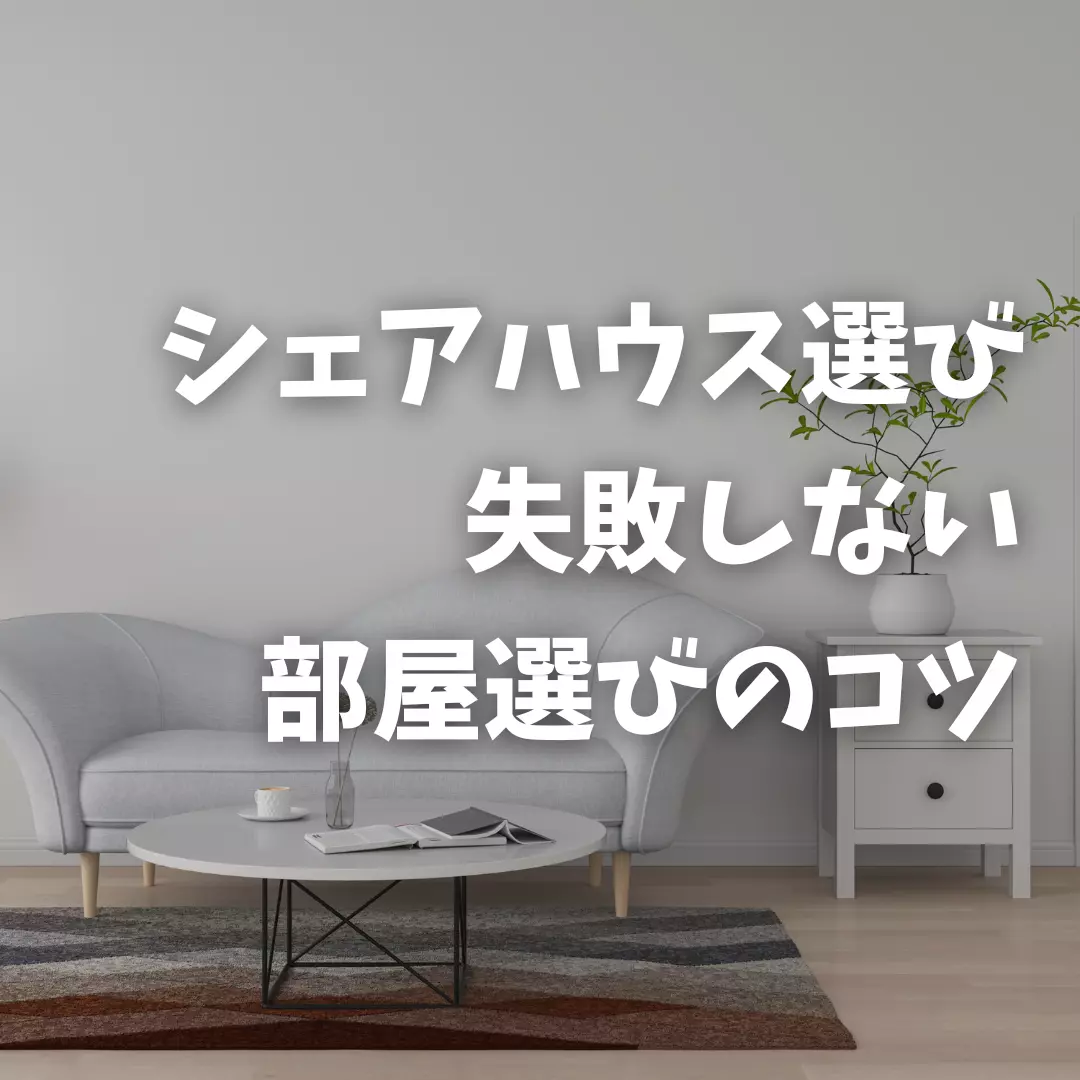"I want to know the different types of share houses."
Which share house is right for me?
If you are thinking about starting a new life in a share house, please read to the end.
When choosing a share house, keep these points in mind
When choosing a share house, it is important to find a room that suits your lifestyle.Consider whether the transportation accessibility and surrounding living environment meet your needs, and make sure that financial burdens such as rent and utility bills will fit within your budget.
The size of the common areas and the level of facilities are also important factors to consider. It is also important to understand that each share house has different rules and manners.
Check the "types" of share houses
In fact, there are different types of share houses.
When choosing a room, it is a good idea to also consider the type of share house.
Generally, they can be divided into four categories:
- High-grade type
- Community Type
- Concept type <
- Price-conscious (dormitory type) <
- Zero community type (privacy-oriented type)
Let's take a look at the features of each.
High-grade type
High-grade shared houses offer high-quality living spaces with luxurious facilities, high-quality furniture, and beautiful interiors.
They have large shared spaces and private rooms, but at the same time the rent tends to be high, making them out of reach for students and young people.
Community Type
A community-type shared house is a type of property that makes it easy for residents to interact with each other and form a community.
We hold regular programs and events that make up our communal living environment, allowing residents to deepen their friendships with each other.
Therefore, it is suitable for people who are looking for not just cheap accommodation, but a lifestyle that emphasizes meeting people and building connections.
Concept type
Concept-based share houses are created as "residences where people with shared themes and interests can gather," and tenants are selected based on a common concept.
For example, hobby-type groups bring together people with the same hobbies, while study-type groups bring together people with specific learning goals.
Concept-based share houses are different from regular share houses in that in order to move in, you must meet certain conditions that correspond to the concept.
Price-conscious (dormitory type)
Rent-focused share houses prioritize keeping rent low and aim to provide the lowest possible cost of living.
Rather than focusing on spacious rooms or luxurious facilities, apartments are characterised by low rent and lots of shared spaces. Compared to living alone, it is cheaper to live here, so they are popular among students and young people.
You can't expect great comfort, but you can keep rent prices down significantly.
It seems to be popular among students and young people because it is cheaper to live here than living alone.
Zero community type (privacy-oriented type)
A zero-community shared house is a type of property that emphasizes complete privacy.
Residents generally do not communicate with each other and can live in their own rooms and living spaces, according to their own rules.
Although shared spaces and facilities are minimal, basic necessities are provided, allowing you to live your own lifestyle while keeping rent low.
However, strict measures will be taken if any rules are violated or any trouble occurs between tenants, so you should be sure to check the rules before moving in and carefully consider whether the property is suitable for you.Search for a room
Only furnished properties with appliances are listed!
Detailed points to consider when choosing a share house room
Of course, type is not the only thing to consider when choosing a share house.
From here, we will explain the following four points in more detail.
- Share house and residents' atmosphere
- Purpose and life style
- Facility
- access
- rent
- rule
Let's take a look at each one.
Share house and residents' atmosphere
When choosing a share house, it is important to make sure that the atmosphere of the residents suits you.
The atmosphere of a shared house changes depending on the residents at the time, so you need to make sure it's a good fit for you.
Get a feel for the atmosphere of the share house by looking at the condition of the living room and kitchen, and conversations with the residents.
For example, a living room cluttered with personal belongings may give off an air of tolerance.
Conversely, a tidy and organized space means it's clean but with a strong emphasis on rules.
We recommend that you actually visit the property and talk to the residents to see if it suits you.Purpose and life style
When choosing a share house, it is important to make sure that your purpose for living and your lifestyle match the concept of the share house.
Choose a share house that suits your purpose, whether that be making more friends, keeping living expenses down, or living in an easily accessible location.
In addition, if residents have different lifestyles, it can lead to stress, such as lack of sleep.
When searching or touring a share house, it is important to check that it suits your purpose and lifestyle.
Facility
The facilities of a shared house are a very important point for living comfortably.
First, let’s look at the shared spaces.
Also, don't forget about the room facilities.
Make sure the property has all the amenities you need, such as heating and cooling, internet access, and furniture.If you have any concerns, it is important to ask the owner or manager.
access
Next, check the distance from the nearest station.
You should also check access from the nearest station.
Additionally, be sure to check the surrounding area where the share house is located.
Other factors that will help you live a stress-free shared house life include considering the culture and natural environment when choosing a place to live.
rent
It can be said that the rent for a shared house is the most important point when considering using that shared house.
Rent varies depending on the size of the room, facilities, location, etc.
In a shared house, rent is determined not only for a private room, but also for use of shared spaces and facilities.
There are differences depending on the facilities and services, so it is important to choose a plan that suits you.
rule
Share house rules are very important for smooth communal living.
For example, basic rules include cleaning and taking out the trash when you move out.
There are also rules regarding usage times of shared spaces, noise, smoking, etc.
Shared houses have clearly defined rules, which means fewer problems and makes for an easy living environment.Therefore, it is important to choose a room while considering whether the rules are something you can follow.
The key to choosing a share house room is the type
In this article, we introduced the different types of share houses and tips for choosing a room to avoid making a mistake.
There are five types of share houses: high-grade type, community type, concept type, price-conscious type (dormitory type), and zero-community type (privacy-conscious type).
Be sure to pay attention to details such as how well you get along with the other residents and how comfortable the shared spaces are.
Find the share house that's right for you and start living comfortably together.
Cross House offers a variety of reasonably priced shared houses in popular areas of Tokyo.
If you are interested, please feel free to contact us.































